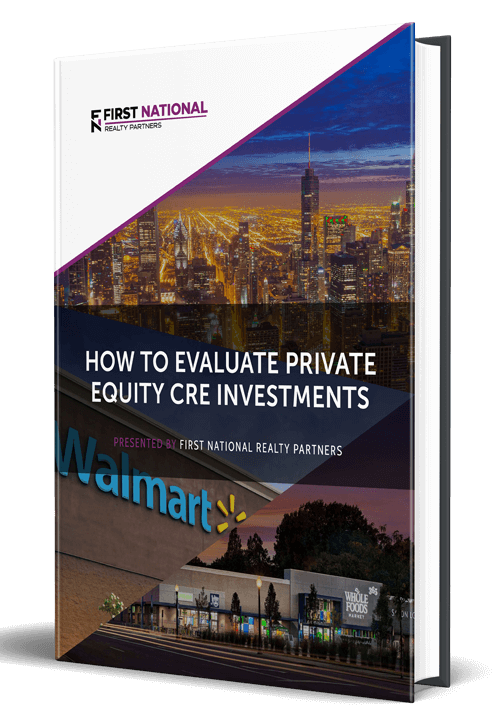Steps to Building a Strong CRE Investment Portfolio
Virtually all commercial real estate investors share certain investment goals. Chief among these is the accumulation of rental properties that can generate strong returns while meeting the investor’s risk tolerance. Understanding how to build a strong commercial real estate investment portfolio is critical to mitigating risk and creating opportunities to generate long-term returns in an investment strategy.
In this article, we are going to discuss eight ways investors can create a strong commercial real estate portfolio. We will break down the steps necessary to make wise property investment decisions. By the end of this article, investors will understand the key steps and actions that must be taken to meet financial goals and see measurable success over time.
First National Realty Partners is a private equity commercial real estate investment firm that specializes in the purchase and management of grocery store-anchored retail centers. If you are an accredited investor and would like to learn more about our current commercial property investment opportunities, click here.
8 Steps to Building a Commercial Real Estate Portfolio
1. Decide On Property Type
The first step to creating an effective commercial real estate portfolio begins with selecting a property type. Commercial real estate is a vast industry that comprises different types of real estate. The property types can be broken down into four major asset classes, also referred to as “the four food groups.” These asset classes are Multifamily Property
- Industrial Property
- Office Buildings
- Retail Property
These property types have different risk and return profiles, and their performance is often dictated by prevailing market conditions. In addition to the four investment types listed above, there are specialty asset classes like hotels and self-storage facilities that can be profitable investment alternatives as well. Investors should consider their core competencies and understand what buildings fall under the umbrella of each asset class before investing. In addition, investors should be aware that investing across multiple asset classes is a great way to diversify their portfolio, reduce portfolio volatility, and hedge risk.
Let’s look at each of these property types in more detail.
Multifamily Properties
A commercial multifamily property is one with five or more units.
Multifamily investors benefit from relative stability in times of economic distress, but they may face challenges with high tenant turnover, short term leases, and increased collection expenses.
Industrial Properties
An industrial property is characterized by properties with an “industrial” purpose and may include standalone warehouses, logistics facilities, or “flex” spaces. Examples of industrial tenants include shipping companies like UPS or Amazon and light manufacturers.
Industrial investors benefit from predictable cash flow, lower operational risks, low CapEx requirements, and generally favorable supply/demand characteristics. But, industrial spaces can be especially vulnerable to economic disruptions and may have high upfront costs due to their large physical footprints.
Office Buildings
Office buildings are simply buildings that exist for the purpose of conducting business activities. They can range from general purpose office space, like those used by consulting firms or financial advisors, to highly specialized space like dental offices or light manufacturing. In addition, these properties can be small, single story buildings located in the suburbs or multi-story high rise buildings that are common in the central business districts of major cities.
As commercial investment properties, office buildings are preferred for their long-term leases and high quality tenants. Many office building owners benefit from the economies of scale that come with consolidating property management for multiple tenants and units within one property.
Retail Properties
Retail properties are those typically located in the commercial areas of cities and towns, and they contain customer facing businesses that sell the goods and services used in everyday life. Retail properties are buildings like shopping centers, malls, and restaurants. These properties largely depend on foot traffic and location to generate dependable revenue for owners
Specialty or Alternative Properties
Specialty properties include buildings like hotels, self-storage facilities, hospitals, and other commercial assets not included in the “four food groups.”
Investors like special purpose properties because they are unique and very difficult to replicate, which helps preserve value.
Each of these property types has their own property management quirks so investors often specialize in one or two types to get to know them inside and out. This type of expertise means they can maximize their chance for a profitable outcome.
2. Determine an Investment Strategy
Determining an effective investment strategy and building a good portfolio begins with understanding one’s goals and outlining a strategic plan to meet certain benchmark metrics. Investors should examine their tolerance for risk by viewing commercial real estate investments as four “risk buckets.”
Investing in Core Assets
A typical core investment is characterized by low leverage (40% – 50%), stable and predictable income, new or like-new construction, high-end finishes, and no major structural or operational issues. In addition, core investments typically have an excellent location with full or near full occupancy.
Core assets fall at the bottom of the risk return ladder and are usually well stabilized commercial properties with high occupancy and good locations. These investments generally target a 6% to 8% rate of return.
Investing in Core-Plus Assets
Core-plus assets are the next safest form of commercial real estate investment and usually provide returns in the 8% to 10% range.
These assets exhibit many of the same features seen in a core asset, but usually lack in some characteristics such as building age or moderate lease rollovers. With some work, these assets can sometimes be converted to core assets and provide a slightly higher rate of return for that reason.
Investing in Value-Add Assets
Value-add assets fall on the moderate to higher end of the risk-return spectrum usually due to occupancy issues, management problems, or deferred maintenance. Through well-executed improvements and renovations, these investments can provide returns in the 10% to 14% range.
The goal of a value add investment strategy is to purchase the property for a good price and to invest some amount of money in renovations and physical improvements to bring the property up to market standards. Renovations could range from minor (new paint and carpet) to major (new roof and structural changes) and they are designed to attract new tenants at higher rental prices.
Investing in Opportunistic Assets
Opportunistic assets are the highest-risk type of commercial real estate investment but have the opportunity to generate the highest returns for investors.
Opportunistic properties tend to have high levels of debt and vacancy. These assets often exhibit a major structural deficiency and can take years to bring to standard. Opportunistic properties could also include ground up development where investors may have to go months or years without seeing any income.
3. Identify How to Invest
Investing in the commercial real estate market can be done actively or passively.
Active investments are those in which the investor must dedicate their own time and resources to acquire and manage the property. The benefit of active investments is investors have more control over the entire investment process but hold a higher degree of risk than most passive investment alternatives.
Passive investments allow for the allocation of funds towards real estate and share in a portion of the returns the property creates. These investments give the investor the ability to lean on the guidance of a trusted real estate professional or firm to manage the day-to-day operations of the property.
4. Determine How to Fund an Investment
Identifying how to fund a commercial real estate investment begins with understanding the different methods or vehicles investors can use to finance property. The most common forms of commercial real estate investments are direct purchases or small partnerships, real estate investment trusts (REITs), and real estate syndications.
Investing Through Direct Purchase
When directly buying a specific real estate asset or assets, investors dedicate their own time and resources to the transaction. The benefit of investing directly is the investor has complete control over the investment. If the investment performs well, the investor can see larger returns than other investment methods.
However, if there is a downturn the investor has a much higher exposure to risk. These investments are considered active investments.
Investing Through a REIT
Investing through a REIT allows investors to generate passive income by investing in a portfolio of real estate assets through the purchase of shares. There are publicly-traded REITs, public non-traded REITs, and private REITs. This is a great way to get started in real estate investing and is the most liquid form of investment.
The drawbacks of investing in a REIT are investors will pay an asset management fee and REIT performance tends to be influenced by stock market volatility, whether positive or negative.
Investing Through Real Estate Syndications
When investing through real estate syndications, an investor’s resources are pooled with others to buy and sell real estate. These investments tend to require a larger financial commitment from the investor base than investing through a REIT, and are typically only available to accredited investors. As a benefit, these investments are less risky than directly purchasing property and investors can share in the passive returns generated by the property.
The structure of nearly all commercial real estate syndicates is the same and it involves two types of members, the General Partners and the Limited Partners.
The General Partner is the deal leader and they are responsible for finding the property, arranging both the debt and equity financing, completing all due diligence, and for all property management tasks. In short, they handle all of the logistics of the deal.
Limited Partners are individually accredited investors – who meet minimum income and net worth requirements – that wish to participate in the syndicate with the hope of earning a return on their investment. The Limited Partner role is completely passive,
5. Find a Property or Properties
The secret to many successful real estate investments is knowing how to find deals that other investors miss. Smart investors lean on the expertise of skilled real estate brokers or firms that have a nose for identifying the best opportunities to acquire property in each market.
6. Perform Adequate Due Diligence
One of the most important aspects of investing in commercial real estate is following proper due diligence. Simply put, proper due diligence means “doing your homework” on a property’s vital information. The due diligence process usually begins with performing a physical inspection, reviewing all legal documents, determining operating costs, double-checking the financials, and having an exit strategy in place.
7. Commit to the Investment
Regardless of the type of commercial real estate investment or method chosen, investors need to have conviction in their investment strategy to reach their goals.
8. Diversification
Diversification is the single most important step in constructing a strong real estate investment portfolio. Real estate investments can be diversified by investing in different property types across various geographical locations. Furthermore, this can be a helpful tool for reducing risk and potentially improving long-term returns.
Why an Investment Portfolio Should Include Commercial Real Estate
Commercial real estate investments can deliver stable returns and appreciate in value even in times of economic uncertainty. Investors should include commercial real estate in their overall investment portfolio because of the cash flow generated, tax benefits, hedge against inflation, the ability to apply leverage, and the fact that real estate is a tangible asset.
Cash Flow
Commercial real estate investments offer cash flow potentials that can be higher than the typical yields on stocks or bonds. Over time landlords are often able to increase rents, which provides a boost to rental income and cash flow.
Tax Benefits
These investments offer various tax benefits related to depreciation and the deferment of capital gains.
IRS rules allow property owners to “depreciate” or expense a certain portion of a property’s value in each year of its useful life. This is a non-cash expense, but it serves to reduce the amount of taxable income produced by the property, therefore providing a reduction in the amount of taxes that must be paid.
Current tax law requires investors to pay long term capital gains taxes when there are investment gains on sale. But, savvy real estate investors can defer them indefinitely using a “1031 exchange.” In this program, capital gains taxes are deferred as long as the sales proceeds are reinvested into another property that is “like kind” to the sold property within a certain time frame.
Hedge Against Inflation
Historically speaking, holding commercial real estate in a portfolio is one of the best hedges against inflation, and inflation has been at record-high levels in recent months. This is due to the fact that commercial real estate tends to appreciate in value during inflationary periods.
Ability to Apply Leverage
The ability to place debt on commercial property gives investors the opportunity to create positive leverage. Positive leverage simply refers to the increased return potential of an investment due to the benefit of applying debt. This allows the individual to invest cash that otherwise would’ve been dumped into the project at higher rates of return than the cost of borrowing.
Additionally, the ability to apply leverage helps investors with diversifying their portfolios. Instead of having to purchase a property entirely with cash, leverage allows real estate investors to make a down payment and then work with lenders to finance the difference. For many commercial real estate investors, this allows them to purchase more properties and reduce the risk of a negative result from any one property.
Commercial Real Estate Is a Tangible Asset
Different from buying stocks and bonds, investing in commercial real estate allows investors to invest in something they can actually see and feel. This provides a level of comfort for many investors that financial assets simply cannot.
Summary of What it Means to Build a Commercial Real Estate Portfolio
In this article, we have discussed a step-by-step process to build a strong commercial real estate portfolio. Commercial real estate investments give investors the ability to diversify their overall portfolios and mitigate risk in their investment approach. Leaning on the advice of a trusted real estate professional or firm is a great way to begin building an effective commercial real estate portfolio.
Interested In Learning More?
First National Realty Partners is one of the country’s leading private equity commercial real estate investment firms. With an intentional focus on finding world-class, multi-tenanted assets well below intrinsic value, we seek to create superior long-term, risk-adjusted returns for our investors while creating strong economic assets for the communities we invest in.
If you are an Accredited Real Estate Investor and want to learn more about our investment opportunities, contact us at (800) 605-4966 or info@fnrpusa.com for more information.






